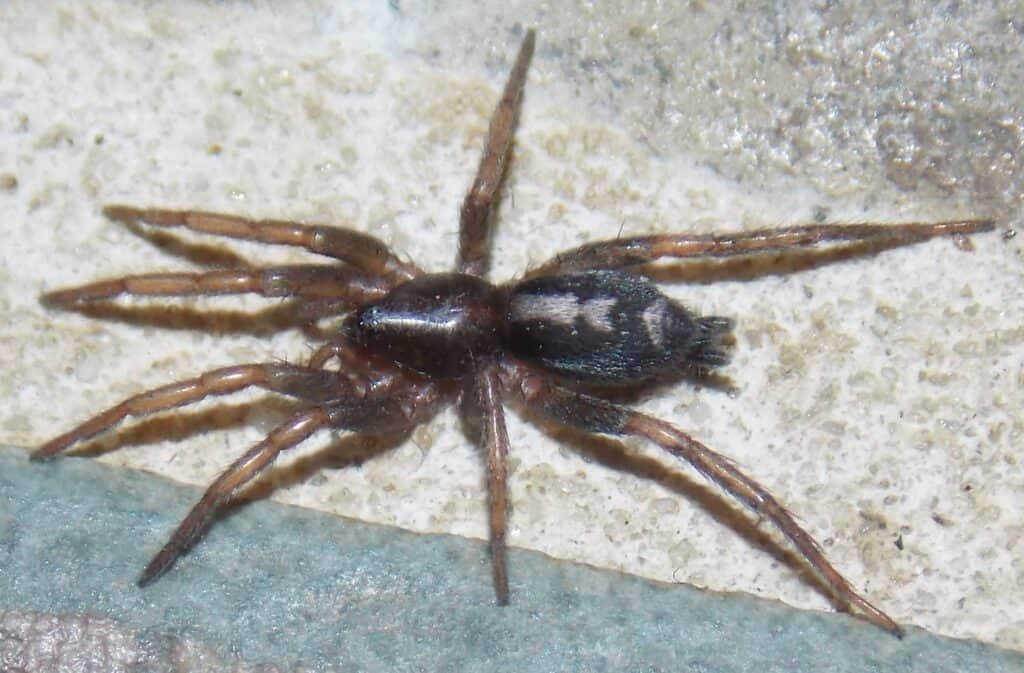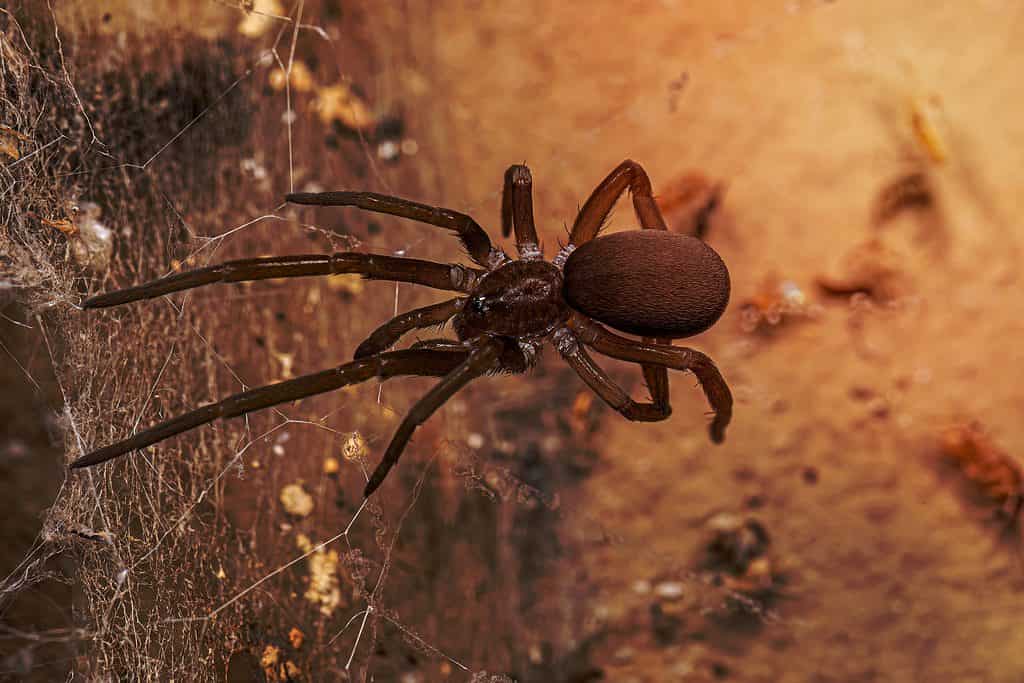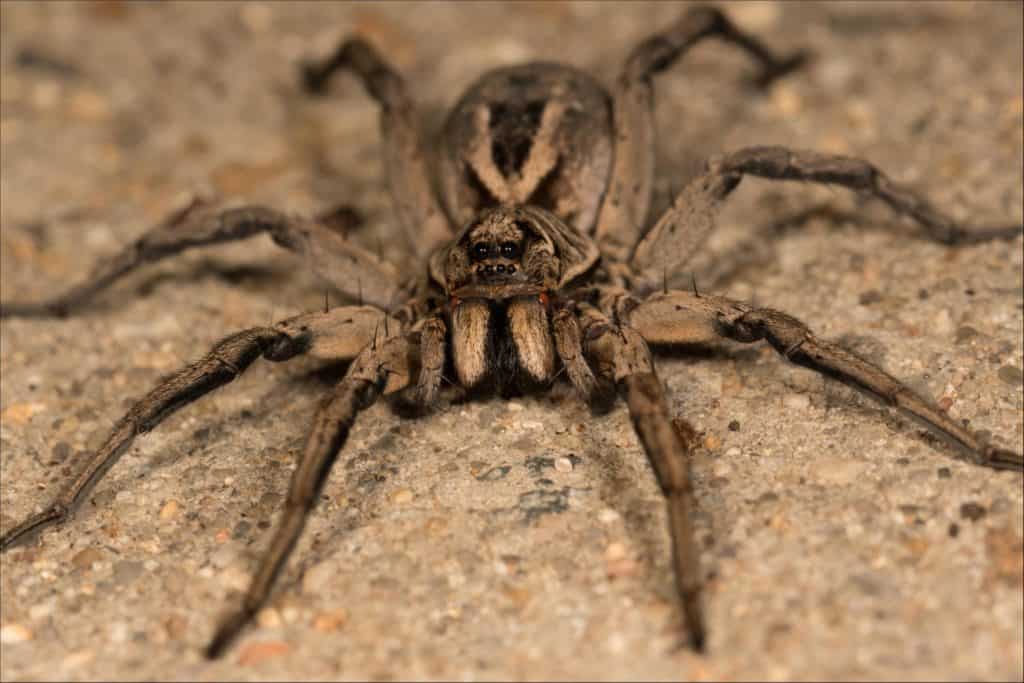
Brown spiders are common in many parts of the world, including Kansas. While many brown spider species are harmless, a few are potentially dangerous to humans. In this article, we’ll discover everything about six brown spiders in Kansas.
1. The Bowl and Doily Spider
The bowl and doily spider (scientific name: Frontinella communis) lives in various parts of North America, including Kansas State. However, despite its intriguing appearance and crucial ecological role, this spider is less well-known than some other species.
Size
The bowl and doily spider is relatively small, with females typically measuring 0.2-0.3 inches long and males slightly smaller at 0.19-0.24 inches. Their leg span can range from 0.6-0.8 inches, with females having longer legs than males. While they may not be the largest spider species in Kansas, they’re still essential to the ecosystem.
Color
The bowl and doily spider’s coloration is typically light brown or yellowish-brown, with darker brown or black markings on their cephalothorax and abdomen. Females tend to have more distinctive markings, while males may appear more uniform in color. These colors and patterns allow the spider to camouflage, making it difficult for predators and prey and to spot them.

The bowl and doily spider gets its name from its uniquely shaped web.
©iStock.com/ErikAgar
Webbing
Its web is among the most unique features of the bowl and doily spider. It’s shaped like a bowl and doily. The spider uses silk to create a flat, circular web (the “doily”) and a small, bowl-shaped web underneath it. The spider typically sits in the bowl, waiting for prey to become trapped in the doily above. However, once the spider detects movement on the web, it quickly moves up to capture its prey.
Preferred Habitats
The bowl and doily spider is a relatively common species in Kansas. They thrive in habitats such as:
- Fields
- Meadows
- Prairies
- Wooded areas
- Along streams
They’re also known to inhabit urban and suburban areas, including:
- Gardens
- Parks
- Other green spaces
The spider’s webbing is well-suited to these habitats, as it’s designed to be flat and close to the ground. This allows the spider to capture prey that may be passing by easily. The web’s bowl-shaped structure also protects the spider. The arachnid can retreat to the bottom of the bowl if threatened.
Geographic Distribution
The bowl and doily spider lives throughout North America, including Kansas. In Kansas, they’re commonly found in the eastern half of the state. While their range is relatively large, it’s limited by several factors, including temperature, humidity, and the availability of suitable habitats.
Behavior
The bowl and doily spider is a patient hunter that spends most of its time waiting in or near its web for prey to come along.
The spider’s web has a bowl-shaped structure at the center, which the spider uses as a hiding spot. When an unsuspecting insect or arthropod crawls across the web, the spider quickly darts out of the bowl and wraps its prey in silk, immobilizing it for later consumption.
Habitat and prey availability influence the spider’s behavior. For example, in areas with a high population of insects and arthropods, the spider may construct larger webs to increase its chances of catching prey. Conversely, in areas with fewer insects, the spider may construct smaller webs and adjust its hunting techniques to be more efficient.
Life Cycle
The bowl and doily spider’s life cycle begins in the fall when the female spider lays her eggs. The eggs will remain in the nest through the winter and hatch in the spring when the weather warms up. The spiderlings will stay close to their mother’s web until they’re large enough to build their own webs. As the spiderlings grow, they shed their skin several times, each time becoming larger and more developed. After reaching maturity, the spider will mate and lay eggs, completing the cycle.
2. The Eastern Parson Spider
Eastern parson spiders (scientific name: Herpyllus ecclesiasticus) are commonly found in various regions of the United States. They are one of the most common brown spiders living in Kansas. These spiders are often misunderstood and feared by people due to their large size and nocturnal habits.
Size and Color
Eastern parson spiders are relatively large, with adults measuring 0.25-0.75 inches long, not including their legs. They have long, slender legs and a distinct cephalothorax and abdomen. They’re typically brown or gray, with black, white, or yellow markings on their body.
Anatomy and Physiology
Eastern parson spiders, like other spiders, have two main body parts: the cephalothorax and abdomen. They have eight legs, each with seven segments, and several pairs of eyes on the front of their cephalothorax. Eastern parson spiders also have two fangs, which they use to capture and subdue their prey. In addition, they have a complex circulatory and respiratory system, which enables them to breathe and move efficiently.

Eastern parson spiders are often misunderstood and feared by people due to their large size and nocturnal habits.
©Fyn Kynd/Flickr – License
Life Cycle
Eastern parson spiders undergo a typical spider life cycle, which includes hatching from an egg sac, molting several times to grow, and reaching adulthood. Females typically lay their eggs in a silken sac, which they guard until they hatch. Then, the young spiders emerge and disperse, growing and molting until adulthood. Eastern parson spiders typically live for about two years, although their lifespan can vary depending on temperature and food availability.
Habitat and Distribution
In Kansas, eastern parson spiders thrive in various habitats, including:
- Grasslands and prairies
- Forests
- Agricultural fields
- Urban and suburban areas
Eastern parson spiders prefer habitats with a diverse range of vegetation and prey, as this provides them with a reliable food source. Therefore, they’re often found in areas with tall grasses and shrubs, featuring good cover and hunting opportunities. They can also live in areas with human activity, such as gardens and parks, where they can prey on insects attracted to flowers and other plants.
Behavior
Eastern parson spiders are known for their nocturnal habits and tendency to hunt for prey at night. They’re active hunters and use their keen sense of sight and touch to locate and capture their prey. Eastern parson spiders use their fangs to inject venom into their prey, which immobilizes it and begins to digest it. Then, they use their speed and agility to capture prey such as insects, spiders, and other arthropods. They’re also known to scavenge for food, eating dead insects and other small animals they find.
Eastern parson spiders are generally solitary creatures, although they may occasionally be found in groups in areas with high prey availability. During mating season, males often search for females and may engage in courtship displays, such as drumming their legs or offering prey as a gift.
Eastern parson spiders have several defense mechanisms to protect themselves from predators. They can move quickly and can jump short distances to escape danger. Additionally, they can release silk from their spinnerets, which can help to entangle and confuse predators.
3. Brown Recluse Spider
The brown recluse spider is fondly referred to as the “violin spider,” and is also known by its scientific name Loxosceles reclusa. This spider is the most dangerous brown spider living in Kansas.
Physical Characteristics and Habitat
The spider has a distinctive violin-shaped marking on its cephalothorax. Its body color ranges from light brown to dark brown. It has long, thin legs. They prefer warm and dry environments and can be found in dark places such as:
- Closets
- Basements
- Attics
They’re most active at night and can be attracted to cluttered areas.

The brown recluse spider is often identified by the violin-shaped marking on its body.
©Nick626/Shutterstock.com
Venom and Symptoms of a Bite
The venom of a brown recluse spider contains a toxin that can cause tissue damage and necrosis, leading to a slow-healing wound that can take weeks or even months to heal. The symptoms of a brown recluse spider bite include:
- Pain
- Swelling
- Itching
- A red or purple blister that can eventually become an ulcer
In severe cases, a brown recluse spider bite can lead to:
- Fever
- Nausea
- Vomiting
Prevention and Treatment of Bites
To prevent brown recluse spider bites, keep your home clean and clutter-free. Seal cracks and crevices, and remove any potential hiding spots. If you suspect a brown recluse spider infestation, contact a professional pest control company for safe and effective removal. If you’re bitten by one, seek medical attention immediately. Apply a cool compress to the affected area to reduce swelling and pain.
Interesting Facts
- Brown recluse spiders aren’t aggressive and will only bite if they feel threatened.
- They can go without food and water for long periods. This has earned them the nickname “famine spiders.”
- Brown recluse spiders have six eyes, arranged in three pairs, which is different from most spiders that have eight eyes.
4. Southern House Spider
Also known by its scientific name Kukulcania hibernalis, the southern house spider is a common brown spider in Kansas.
Physical Characteristics and Habitat
The southern house spider is a medium-sized spider with a brown body and long, thin legs. They’re commonly found indoors, particularly in:
- Homes
- Barns
- Sheds
Their webs are often built in corners or in places where they can catch flying insects.

A female southern house spider on a web.
©postolocanu/Shutterstock.com
Venom and Bite
The southern house spider’s venom isn’t considered dangerous to humans. They aren’t aggressive and will only bite if they feel threatened or cornered. A bite from a southern house spider may cause some mild pain and swelling, but the symptoms typically go away on their own within a few hours.
Interesting Facts
- They have unique web-building abilities. For example, they build funnel-shaped webs that are typically flat against a surface rather than suspended in the air like other spider webs.
- They’re also known for their speed and agility, which makes them effective hunters.
5. Wolf Spiders
Wolf spiders (scientific name: Lycosidae) are large, hairy brown spiders commonly found in Kansas.
Physical Characteristics and Habitat
Wolf spiders are relatively large, with brown bodies and long, hairy legs. As a result, they’re often mistaken for tarantulas due to their size and appearance. Wolf spiders can be found in various habitats, including:
- Grasslands
- Woodlands
- Deserts
They’re also commonly found indoors, particularly in basements and crawl spaces.

Wolf spiders are relatively large, with brown bodies and long, hairy legs.
©Katarina Christenson/Shutterstock.com
Venom and Bite
Wolf spiders’ venom isn’t considered dangerous to humans, although a bite can be painful. The symptoms of a wolf spider bite include:
- Swelling
- Redness
- Pain
But these symptoms typically go away on their own within a few hours.
Interesting Facts
- Wolf spiders have a unique hunting style. They don’t construct webs to ensnare their prey. They instead actively hunt for their food.
- They carry their egg sacs on their spinnerets. They also carry their young on their backs until they’re old enough to hunt independently.
6. The Black-Footed Yellow Sac Spider
This spider, also known by its scientific name Cheiracanthium inclusum, is a small, pale yellow-brown spider commonly found in Kansas.
Physical Characteristics and Habitat
Yellow sac spiders are relatively small, with a pale yellow-brown body and long, thin legs. They’re commonly found in homes, particularly:
- In corners
- In closets
- Under furniture
They build small silk tubes for shelter during the day and emerge at night to hunt for insects.

Yellow sac spiders are relatively small, with a pale yellow-brown body and long, thin legs.
©Austin Campbell / Creative Commons – License
Venom and Bite
Black-footed yellow sac spiders’ venom isn’t considered dangerous to humans, although a bite can be painful. The symptoms of a yellow sac spider bite include:
- Redness
- Swelling
- Burning sensation
But these symptoms typically go away on their own within a few hours.
Interesting Facts
- Yellow sac spiders can crawl on smooth surfaces like glass or polished metal.
- They don’t construct webs to catch their prey but instead actively hunt for their food.
The photo featured at the top of this post is © Physics_joe/Shutterstock.com
Thank you for reading! Have some feedback for us? Contact the AZ Animals editorial team.







